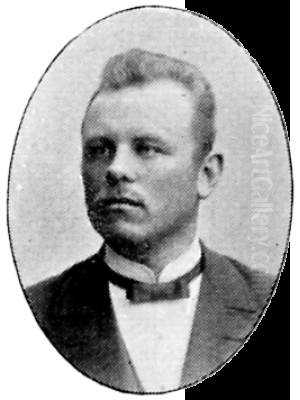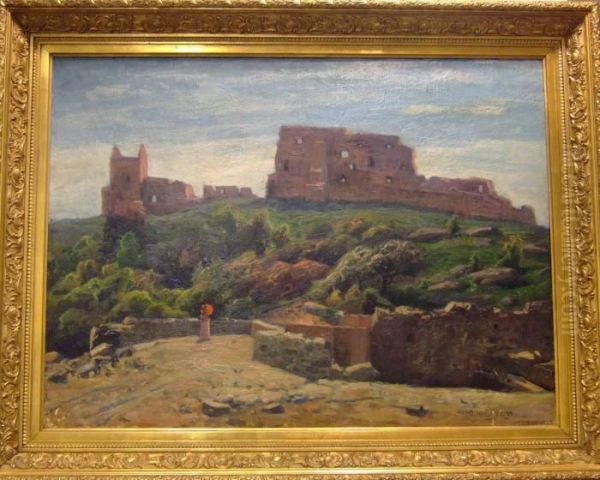
Oscar Andreas Hullgren (1869-1948) stands as a notable figure in the landscape of Swedish art, a painter whose career bridged the late 19th and early 20th centuries. His work, primarily focused on landscapes, captured the unique atmosphere and light of the Nordic region, and he was an active participant in the vibrant artistic communities of his time. Though perhaps not as internationally renowned as some of his contemporaries, Hullgren's contributions to Swedish art, particularly his evocative depictions of nature and his engagement with the prevailing artistic currents, merit closer examination.
Early Life and Artistic Inclinations
Born in Sweden in 1869, Oscar Hullgren emerged during a period of significant artistic transformation across Europe. The dominant academic traditions were being challenged by new movements, from the lingering influences of Romanticism and Realism to the burgeoning forces of Impressionism and its subsequent offshoots. While specific details of Hullgren's early training are not extensively documented in readily available broad historical surveys, it is typical for artists of his generation in Sweden to have pursued studies at the Royal Swedish Academy of Fine Arts in Stockholm or sought training abroad, perhaps in Paris, which was the undisputed center of the art world.
His professional life was dedicated to painting, and he became recognized for his skill in capturing the essence of the Swedish and broader Scandinavian landscapes. His lifespan, 1869-1948, places him squarely within a dynamic era that saw the rise of modernism, and his work reflects an engagement with these evolving artistic dialogues, particularly leaning towards a Post-Impressionistic sensibility.
The Allure of Christiansø: An Artists' Haven
A significant aspect of Hullgren's artistic life was his connection to Christiansø, a small, fortified island northeast of Bornholm in the Baltic Sea, part of Denmark's Ertholmene archipelago. This remote and picturesque location became a magnet for artists from both Sweden and Denmark, particularly in the early 20th century. Its dramatic cliffs, historic fortifications, unique light, and relative isolation provided an inspiring environment conducive to focused artistic creation and communal exchange.

Hullgren was among the Swedish artists who frequented Christiansø, either residing there for periods or making extended visits. He became part of an informal artists' colony, a collective of painters drawn to the island's rugged beauty and the camaraderie of fellow creatives. This environment undoubtedly fostered artistic exchange, mutual influence, and perhaps friendly competition, all of which could have shaped the development of his style and thematic concerns. The shared experience of interpreting the same dramatic landscapes often leads to fascinating variations in artistic output, reflecting individual temperaments and approaches.
Artistic Style: Echoes of Post-Impressionism
Oscar Hullgren's primary artistic style is generally characterized as Post-Impressionism. This broad movement, which emerged in the late 1880s and extended into the early 20th century, was not a single cohesive style but rather a collection of individual responses to Impressionism. Post-Impressionists, while often retaining the bright colors and visible brushwork of their predecessors, sought to imbue their work with greater emotional depth, symbolic content, and structural coherence. They emphasized the subjective experience of the artist, moving beyond the mere optical recording of a scene.
In Hullgren's work, this Post-Impressionist leaning would likely manifest in a heightened use of color for expressive rather than purely descriptive purposes, a simplification of forms to convey underlying structures, and a focus on the emotional atmosphere of the landscapes he depicted. Nordic Post-Impressionism often carried a particular sensitivity to the qualities of light – the long twilights, the stark contrasts of winter, and the ethereal glow of summer nights – and a deep connection to the natural environment, sometimes tinged with romantic or symbolic undertones. Hullgren's landscapes would likely reflect these regional characteristics, filtered through his personal artistic vision.
Notable Works and Recognition
Identifying a definitive list of Oscar Hullgren's most "famous" works can be challenging without access to comprehensive exhibition catalogues or a catalogue raisonné. However, information suggests that he was particularly known for his landscape paintings. One such work often associated with him is titled Bornholm med Hammershus (Bornholm with Hammershus) or variations like Utsikt över Bornholm med Hammershus (View over Bornholm with Hammershus). Hammershus is a significant medieval fortification on the island of Bornholm, a dramatic subject favored by many artists. While one source problematically suggests this work was painted in 1869 (the year of his birth, making this date impossible for a mature work), the existence of paintings depicting this iconic Bornholm scene by Hullgren is plausible and aligns with his focus on the region. Such a piece would likely be a testament to his skill in capturing the grandeur and historical resonance of the landscape. It is also noted that a work by this title is held in the collection of the Nationalmuseum in Stockholm, underscoring its significance.
Hullgren's talent did not go unrecognized during his lifetime. He participated in significant exhibitions, a key way for artists to gain visibility and critical appraisal. For instance, he is documented as having received an honorable mention or award at a Swedish exhibition in 1916. Furthermore, his name appears in connection with an award, possibly a Medal of Honor, at the Panama-Pacific International Exposition held in San Francisco in 1915. This exposition, often referred to as "The Jewel City," was a major international event, and participation and recognition there would have been a significant achievement, indicating a degree of international standing for his work.
Contemporaries and the Christiansø Circle
Oscar Hullgren was part of a vibrant artistic milieu, and his time on Christiansø placed him in direct contact with numerous other painters. Understanding these connections helps to situate his work within the broader context of Nordic art of the period.
Among the artists directly associated with Hullgren and the Christiansø colony was the Swedish painter Karl Isacson (1878-1922). Isacson was a pivotal figure in early Scandinavian modernism, known for his intense colorism, influenced by French Fauvism and artists like Cézanne. His presence on Christiansø would have provided a stimulating, modernizing influence.
Another figure mentioned in connection with Hullgren on the island is Kamma Salto (1890-1946), a Danish painter. She was married to Axel Salto (1889-1961), a prominent Danish modernist artist known for his ceramics, graphic works, and paintings, and a member of the influential group "De Fire" (The Four). While Axel Salto's direct interaction with Hullgren on Christiansø isn't explicitly detailed in the provided snippets, his wife's presence suggests a link to this modernist circle.
The Christiansø and broader Bornholm art scene attracted many other significant Danish painters. Oluf Høst (1884-1966) is perhaps the most famous of the Bornholm painters, deeply connected to the island's landscape, which he depicted with expressive force and a rich, dark palette. Edvard Weie (1879-1943), sometimes spelled Edward Weie, was a key figure in Danish modernism, known for his lyrical colorism and romantic compositions, and he too spent significant time painting on Christiansø. His work often explored themes of figures in landscapes, imbued with a poetic sensibility.
Other Danish artists who were part of this extended Bornholm/Christiansø sphere include:
Ole Rude (1905-1993), known for his Bornholm landscapes.
Mogens Lorentzen (1892-1979), a versatile artist who also worked on Christiansø.
Sigurd Swane (1879-1973), a prominent Danish modernist painter influenced by French art, particularly Fauvism and Cubism, who also painted on Bornholm.
Henning Køie (1870-1931), another artist associated with the Bornholm school.
Johannes Gitz-Johansen (1897-1977), primarily known for his depictions of Greenland, but also connected to the Bornholm artistic environment.
The group "De Fire," formed in 1920, included Karl Larsen (1897-1977), Vilhelm Lundstrøm (1893-1950), Svend Johansen (1890-1970), and the aforementioned Axel Salto. While their formation post-dates the early period of the Christiansø colony, their members were active in the broader modernist currents influencing Danish and Swedish art. Karl Larsen, for instance, had a close friendship with Vilhelm Lundstrøm, and their artistic development in terms of color and composition was mutually influential. Larsen was inspired by contemporary French art during his time in Southern France with "De Fire." Vilhelm Lundstrøm himself became one of Denmark's most important modernist painters, known for his highly stylized still lifes and figure compositions, often with a Cubist influence. His connection to the Bornholm/Christiansø sphere, even if indirect through associates, underscores the interconnectedness of the Nordic art scene.
These artists, whether directly collaborating with Hullgren or sharing the inspirational environment of Christiansø and Bornholm, contributed to a rich artistic dialogue. The exchange of ideas, techniques, and inspirations within such a community would have been invaluable, pushing artists to explore new directions and refine their individual voices. Hullgren's interactions with these painters, ranging from fellow Swedes to leading Danish modernists, would have undoubtedly enriched his artistic practice.
Artistic Achievements and Historical Evaluation
Oscar Hullgren's artistic achievements lie primarily in his dedicated portrayal of the Nordic landscape, filtered through a Post-Impressionist lens. His ability to capture the specific light and atmosphere of regions like Bornholm and Christiansø, and his participation in the artistic life of these communities, mark him as a significant contributor to the Swedish art of his time.
His recognition through awards, such as the one at the 1916 Swedish exhibition and potentially at the Panama-Pacific International Exposition, indicates that his work was well-regarded by his contemporaries and met the standards of significant juried shows. The inclusion of his work in the Nationalmuseum in Stockholm further solidifies his place in the narrative of Swedish art history.
While he may not have been a radical innovator on the scale of some of the leading modernists, his consistent output and his engagement with the prevailing artistic trends of his era demonstrate a committed and skilled painter. Artists like Hullgren form the essential fabric of a national art scene, contributing to its richness and diversity. His work provides a valuable window into how international movements like Post-Impressionism were interpreted and adapted within a specific Nordic context, emphasizing a connection to place and a subjective response to nature.
The historical evaluation of Oscar Hullgren positions him as a respected Swedish landscape painter who was an active part of the important Christiansø artist colony. His legacy is tied to his evocative depictions of the natural world and his role within a community of artists who sought inspiration from the unique environments of the Baltic islands. His paintings serve as a testament to the enduring appeal of landscape art and the vibrant artistic exchanges that characterized the early 20th century in Scandinavia.
Conclusion: A Legacy in Light and Landscape
Oscar Hullgren's journey as an artist reflects a deep engagement with the landscapes of his native Sweden and the broader Nordic region. His association with the artists' colony on Christiansø highlights the importance of place and community in artistic development. Through a Post-Impressionist approach, he sought to convey not just the visual appearance of the scenes before him, but also their emotional resonance and underlying character.
While further research into specific exhibitions, critical reviews, and a more comprehensive catalogue of his works would undoubtedly provide a more nuanced understanding of his career, Oscar Hullgren remains a noteworthy Swedish painter. His contributions to landscape painting, his participation in significant artistic circles, and the recognition he received during his lifetime affirm his place in the annals of early 20th-century Nordic art. His works continue to offer a glimpse into the distinctive beauty of the Scandinavian world, captured by an artist sensitive to its myriad moods and enduring light.